The effects of Z13752A, a combined ACE/NEP inhibitor, on responses to coronary artery occlusion; a primary protective role for bradykinin
- PMID: 10683191
- PMCID: PMC1571895
- DOI: 10.1038/sj.bjp.0703109
The effects of Z13752A, a combined ACE/NEP inhibitor, on responses to coronary artery occlusion; a primary protective role for bradykinin
Abstract
The effects on the responses to coronary artery occlusion of a combined ACE/NEP inhibitor (Z13752A) were examined in anaesthetized dogs. A 1 h infusion of Z13752A (128 microgram kg(-1) min(-1) intravenously) decreased arterial blood pressure (by 11+/-3%; P<0. 05) and increased coronary blood flow (by 12+/-4%, P<0.05). There were no other significant haemodynamic changes. Z13752A inhibited both NEP and ACE enzymes both in dog plasma and in tissue (lung ACE; kidney NEP). Pressor responses to angiotensin I in vivo were inhibited and systemic vasodilator responses to bradykinin were potentiated. When the left anterior descending coronary artery was occluded for 25 min, Z13752A markedly reduced the severity of the resultant ventricular arrhythmias. No ventricular fibrillation (VF) occurred (compared to 7/16 in the controls; P<0.05), and ventricular tachycardia (VT) was reduced (VT in 2/9 dogs treated with Z13752A cp. 16/16 of controls; episodes of VT 0.2+/-0.1 c.p. 10.7+/-3.3; P<0. 05). Reperfusion of the ischaemic myocardium led to VF in all control dogs but occurred less frequently in dogs given Z13752A (survival from the combined ischaemia-reperfusion insult 67% c.p. 0% in controls; P<0.05). Z13752A reduced two other indices of ischaemia severity; epicardial ST-segment elevation and inhomogeneity of electrical activation. These protective effects of Z13752A during ischaemia and reperfusion were abolished by the administration of icatibant (0.3 mg kg(-1), i.v.) a selective antagonist of bradykinin at B(2) receptors; the ischaemic changes in dogs given both icatibant and Z13752A were similar to those in the controls. We conclude that this ACE/NEP inhibitor is effective at reducing the consequences of coronary artery occlusion in this canine model and that this protection is primarily due to potentiation of released bradykinin. British Journal of Pharmacology (2000) 129, 671 - 680
Figures

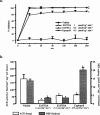

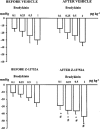
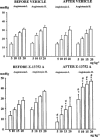
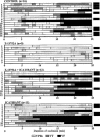

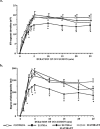
Similar articles
-
Local inhibition of bradykinin degradation in ischemic hearts.J Cardiovasc Pharmacol. 1990;15 Suppl 6:S99-109. J Cardiovasc Pharmacol. 1990. PMID: 1697370
-
Attenuation of the antiarrhythmic effects of ischaemic preconditioning by blockade of bradykinin B2 receptors.Br J Pharmacol. 1994 Dec;113(4):1167-72. doi: 10.1111/j.1476-5381.1994.tb17120.x. Br J Pharmacol. 1994. PMID: 7534181 Free PMC article.
-
The effect of acute simvastatin administration on the severity of arrhythmias resulting from ischaemia and reperfusion in the canine: Is there a role for nitric oxide?Eur J Pharmacol. 2014 Jun 5;732:96-104. doi: 10.1016/j.ejphar.2014.03.021. Epub 2014 Mar 28. Eur J Pharmacol. 2014. PMID: 24685640
-
Role of kinins in the pathophysiology of myocardial ischemia. In vitro and in vivo studies.Diabetes. 1996 Jan;45 Suppl 1:S51-8. doi: 10.2337/diab.45.1.s51. Diabetes. 1996. PMID: 8529801 Review.
-
Bradykinin-mediated cardiovascular protective actions of ACE inhibitors. A new dimension in anti-ischaemic therapy?Drugs. 1997;54 Suppl 5:59-70. doi: 10.2165/00003495-199700545-00009. Drugs. 1997. PMID: 9429846 Review.
Cited by
-
Cardioprotective actions of peptide hormones in myocardial ischemia.Heart Fail Rev. 2007 Dec;12(3-4):279-91. doi: 10.1007/s10741-007-9029-y. Heart Fail Rev. 2007. PMID: 17516166 Review.
-
Kallidin-like peptide mediates the cardioprotective effect of the ACE inhibitor captopril against ischaemic reperfusion injury of rat heart.Br J Pharmacol. 2006 Jul;148(6):825-32. doi: 10.1038/sj.bjp.0706799. Epub 2006 Jun 12. Br J Pharmacol. 2006. PMID: 16770319 Free PMC article.
-
Vasopeptidase inhibitors: will they have a role in clinical practice?Br J Clin Pharmacol. 2004 Jan;57(1):27-36. doi: 10.1046/j.1365-2125.2003.01947.x. Br J Clin Pharmacol. 2004. PMID: 14678337 Free PMC article. Review.
-
Role of bradykinin in preconditioning and protection of the ischaemic myocardium.Br J Pharmacol. 2002 Feb;135(4):843-54. doi: 10.1038/sj.bjp.0704548. Br J Pharmacol. 2002. PMID: 11861312 Free PMC article. Review. No abstract available.
-
A common mechanism in the protective effects of preconditioning, cardiac pacing and physical exercise against ischemia and reperfusion-induced arrhythmias.Exp Clin Cardiol. 2005 Fall;10(3):200-5. Exp Clin Cardiol. 2005. PMID: 19641688 Free PMC article.
References
-
- DANIELL H.B., CARSON R.R., BALLARD K.D., THOMAS G.R., PRIVITERA P.J. Effects of captopril on limiting infarct size in conscious dogs. J. Cardiovasc. Pharmacol. 1984;6:1043–1047. - PubMed
-
- EHRING T., BAUMGART D., KRAJCAR M., HÜMMELGEN M., KOMPA S., HEUSCH G. Attenuation of myocardial stunning by the ACE inhibitor ramiprilat through a signal cascade of bradykinin and prostaglandins but not nitric oxide. Circulation. 1994;90:1368–1384. - PubMed
-
- ERDõS E.G., SKIDGEL R.A. Neutral endopeptidase 24.11 (enkephalinase) and related regulators of peptide hormones. FASEB J. 1989;3:145–151. - PubMed
-
- GOTO M., LIU Y.G., YANG X.M., ARDELL J.L., COHEN M.V., DOWNEY J.M. Role of bradykinin in protection of ischemic preconditioning in rabbit hearts. Circ. Res. 1995;77:611–621. - PubMed
Publication types
MeSH terms
Substances
LinkOut - more resources
Full Text Sources
Other Literature Sources
Miscellaneous

